How to clean a chimney from soot: how to properly clean a smoke duct
Heating devices that burn wood or other solid fuels require periodic cleaning.Deposits on the walls of the chimney are dangerous not only due to narrowing of channels, collapses and blocking of passages, but also due to the ignition of deposits, which can lead to a fire in the house. The danger must be eliminated in a timely manner. Do you agree?
We will tell you how to maintain the smoke duct so that it does not pose a threat to you and your property. The article presented for your review describes in detail how to clean a chimney from soot, how often and when it needs to be done. Effective preventive measures are given for careful owners.
The content of the article:
Chimney cleaning: chemical and mechanical
Carrying out mechanical cleaning is a rather complex and labor-intensive process. Therefore, as a rule, it is carried out no more than 1-2 times a year. But with intensive use of heating devices, this is often not enough.
In addition, the more deposits form on the channel walls, the more the efficiency decreases - the fuel efficiency decreases.
Mechanical cleaning of smoke ducts
The purpose of mechanical cleaning is to get rid of soot and soot and conduct a preventive inspection. Even if measures were taken throughout the heating season to minimize accumulations on the walls of the chimney, there is still a possibility of malfunctions in the chimney.

Preparatory work before removing soot
If cleaning begins from a section of the chimney pipe located above the roofing, care must be taken to ensure safety. A safety rope is used for this.
If there is none, then a rope is tied around the belt, the second end of which is fixed around a reliable support - a chimney pipe or a tree growing on the side opposite to the placement of the chimney.
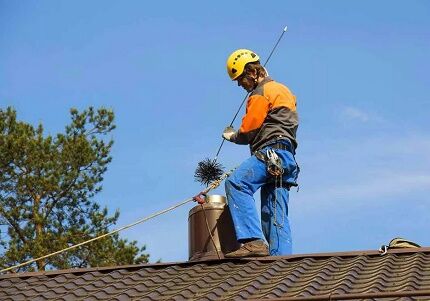
To minimize the entry of soot into the house, and it will be quite difficult to clean it later, close the firebox doors and soot pans tightly. The fireplace is covered with a damp cloth.
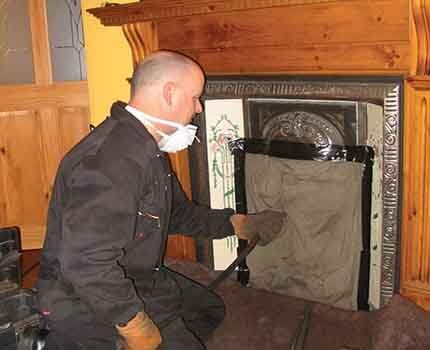
Cleaning sequence
Before you begin, you need to find out how you can clean the chimney from below without climbing out onto the roof. And only if this is not possible, do they begin cleaning. Start with a section of pipe protruding above the roof, having first removed spark arrester and/or deflector.
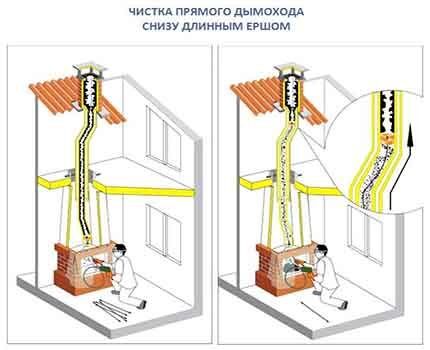
If cleaning begins from the roof, then work is carried out in the following order:
- Having put all the devices in a bucket, they climb onto the roof and secure the safety rope.
- Remove the fungus or deflector, if any, from the pipe head.
- They clean the smoke channel, trying to remove all deposits - holding it by the cable, lowering and lifting the brush with a weight.
- After the channel is cleaned, put the tools in a bucket and install the deflector in place. Having unfastened the safety rope, they go down.
- In the house or attic, open the cleaning doors (soot pans) and remove the crumbled soot.
Continuing to move from the upper channels to the lower ones, cleaning is carried out, after which the sprinkled soot is selected and the doors are closed.
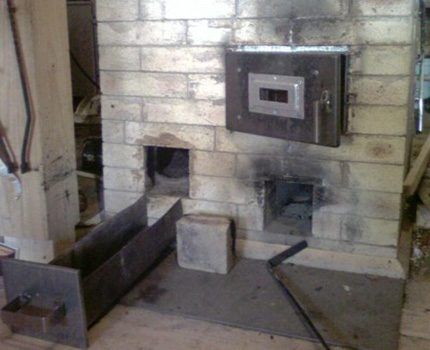
All cleaning operations are carried out carefully. Cover the floor with newspaper, oilcloth or thick fabric. Soot that has fallen on the floor is first collected with a vacuum cleaner or a dry broom or rag. After everything has been assembled, wash the surfaces.
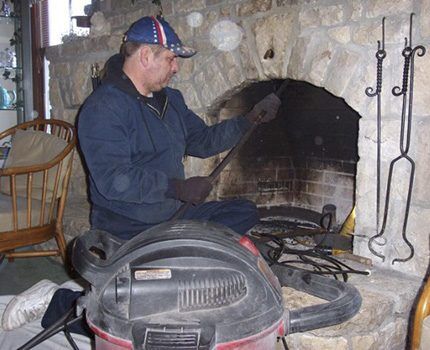
It is better to choose a vacuum cleaner with a plastic container, or use industrial electrical equipment - they are easier to clean from dirt. There are also models specifically designed for collecting soot and ash.
How to make a ruff with your own hands?
In order not to buy a brush, you can make your own device for cleaning the chimney from plastic bottles or a metal cable.
Plastic is more versatile and suitable for all types of chimneys.Whereas a metal brush can damage the protective coating of galvanized steel chimneys or tear off the clay layer that is applied to make the internal surfaces smooth.
To make a brush from a plastic bottle, you will need a steel cable with a diameter of about 2 mm, a clamp, and two plastic one and a half liter bottles. The bottles are cut in half (crosswise), dissolved into strips, leaving the upper part intact.
Small diameter holes are made in the bottoms using a hot metal object (wire, screwdriver). The same hole is made in the lids.
The halves are connected to each other by putting them on a threaded hook in the following sequence: bottom, neck with lid, neck with lid, bottom. Secure the connection using two nuts and two washers.
Then a connector is put on the end of the hook and a threaded rod (rod) of the appropriate diameter is screwed onto it. You can also use a plumbing rope to clean sewer pipes. The cable length can be about 2 m.

To clean the blockage in the chimney, you can use a brush attached to a cable, to which a heavy object is attached from below. A metal ball can be used as a weighting agent. It is not advisable to use objects with a displaced center of gravity, as they can turn over and get stuck in the chimney.
Chemical cleaning
They will help to effectively prevent the accumulation of soot in the chimney. special means. They are intended for prevention and are designed to be used regularly.
These additives are used during the combustion of wood. As a result, the soot is destroyed during the combustion stage. They are used before cleaning the chimney mechanically, and also periodically throughout the heating season.
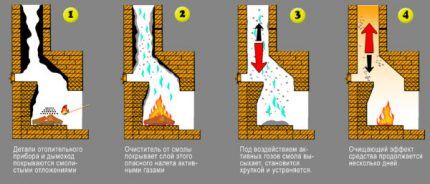
Using powder products
A powder chemical cleaner is designed to burn deposits formed on the walls of smoke channels and fireboxes. The product is burned together with solid fuels and prevents the deposition of soot and tar.
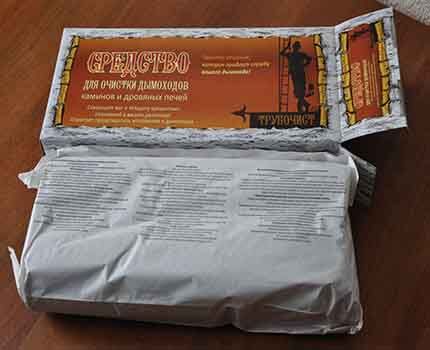
The use of a catalyst allows you to partially burn soft deposits and loosen hard deposits. Systematic use of the product allows you to maintain the efficiency of heating systems and furnace devices.
The rate of addition of powder is approximately 1-2 kg per ton of fuel or 1-2 tablespoons for every 10 kg. When using firewood from resinous trees, a catalyst is used every third load. A catalyst that is used correctly should produce white smoke with a yellowish tint.
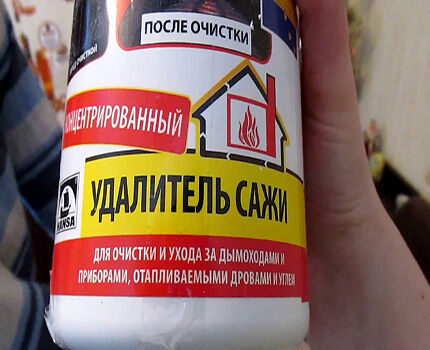
Cleaning the chimney with a chimney sweeper
One of the effective means of combating creosote deposits is a special log. This is an absolutely non-toxic product that can be used to clean stoves, fireplaces, boilers that burn wood or coal.
enjoy log "Chimney sweep" very simple. To do this, you need to set it on fire and leave it to burn. As it burns, the smoke, enriched with the salt mineral, penetrates the creosote, drying it out and making it flowable. Thus, it is possible to almost completely clean the channel walls of deposits.
Folk remedies for combating soot accumulation
The most famous old-fashioned way of dealing with blockages in chimneys is burning potato peelings. Their use is most effective during intense combustion.
Under the influence of high temperature, steam with a high starch content is formed, which loosens and softens deposits. The soot flakes off and falls off. This method is suitable for preventing channel blockage and as preparation for mechanical cleaning.
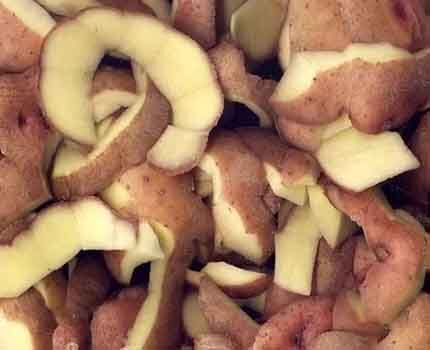
Burning aspen wood in large quantities as a method of cleaning soot from a chimney, although considered effective, can lead to bad consequences.
High temperatures, which lead to the ignition of soot in the chimney channels, can cause a fire if there are cracks or damage in it. In addition, not all metal sandwich chimneys can be operated at very high temperatures.
How to reduce chimney pollution?
It is common for different types of heating devices to accumulate soot in the smoke ducts at different rates.So, the more protrusions, roughnesses and irregularities, the more soot settles on the walls. Numerous turns or improperly laid smoke channels also prevent soot from escaping into the atmosphere.
But if the stove, fireplace, boiler are already installed, then there is no way to change its design. But you can minimize other negative factors that lead to severe contamination of the chimney.
Choosing the optimal fuel
When any fuel burns in a chimney, a deposit of soot and soot forms. But one type can form more deposits than others. The intensity of pollution can be reduced if you use the “right” fuel.
Wood from different tree species has different chemical composition. Different contents of resin, oils, tar, and creosote affect the degree of sediment formation on chimney pipes. The less these substances are in the wood, the less soot will be formed during the combustion process. Other types of solid fuels also contribute to pollution to varying degrees.
Which fuel produces soot more strongly than others:
- firewood from coniferous species - spruce, pine;
- birch firewood, which has a high tar content;
- Briquettes and pellets made from seed husks, due to their high oil content, produce intensive soot formation.
It should also be said that burning household waste, especially plastic, in a stove also contributes to the formation of plaque.
In contrast to these types of fuel, firewood from oak, hornbeam, beech, walnut, sycamore, pear, and apple can be noted. These hard rocks are much less likely to cause contamination of smoke ducts.
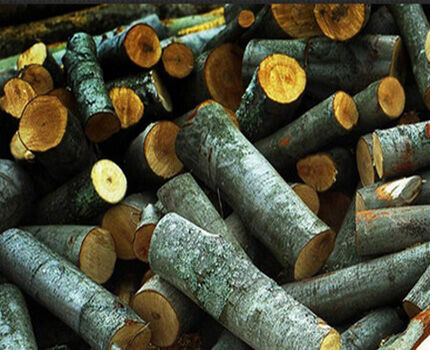
Burns well and leaves a little soot behind. sawdust briquettes, otherwise called Eurowood. When burning, they do not spark, and weakly absorb moisture, so they can be stored in kitchens next to the stove.
Dependence on humidity and combustion temperature
It is highly advisable to use dry wood for heating premises - the drier the better. The fact is that when wet fuel is burned, the ash, under the influence of steam, rises with it and sticks together into lumps. It becomes heavier and cannot leave the chimney. As a result, it accumulates inside the chimney in the form of soot.
Therefore, they need to be prepared in advance and stored under a canopy, in special covered premises, sheds. In such conditions, it will be possible to achieve 15-20% humidity. In this case, the degree of dryness will always fluctuate depending on the air humidity indoors and outdoors.
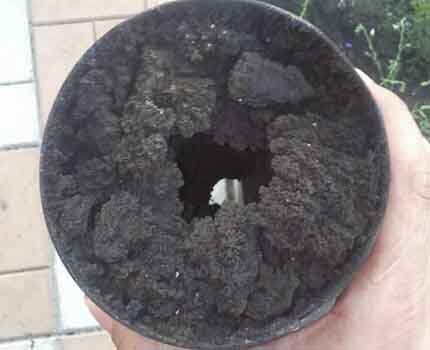
The amount of soot formation is also affected by the combustion temperature. The worse the firewood burns, the greater the degree of contamination, the more often you will have to chimney cleaning.
This is due to the fact that at low temperatures an excess of carbon particles is formed, which settles in the form of soot and soot. This phenomenon is especially typical for the initial combustion, when the wood is just starting to burn.
Therefore, when lighting a stove or fireplace, you need to strive to increase the temperature in the firebox as quickly as possible - heat the stove with dry wood, use more thin and dry wood chips.
In addition, after the fire dies out, it is necessary to maintain heat. To do this, as soon as all the fuel has burned out in the stove, close the gate.And then, during the next kindling, the temperature inside the stove will be much higher than if it had not been closed.
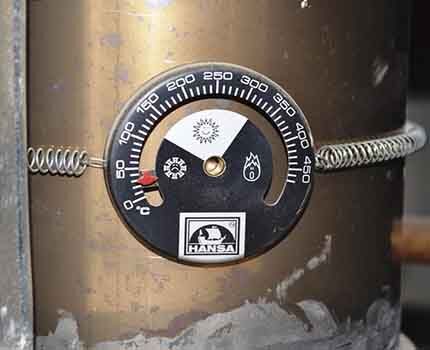
Conclusions and useful video on the topic
Video #1. Use of chemicals:
Video #2. Cleaning smoke ducts using potato peelings:
Video #3. How to make a brush from a plastic bottle and use it to clean a chimney:
You can check how you managed to clear the chimney of soot using a newspaper. It is set on fire and brought to the firebox and to the cleaning doors.
If there is no traction in any section, then, most likely, the blockage in the channels located above could not be removed. In this case, it is better to invite a chimney sweep who will help to accurately determine the cause and cope with poor draft.
Tell us about how you cleaned the chimney at your own dacha or in a country house. Please write comments in the block below the text of the article. Ask questions, share information useful for site visitors, leave photographs on the topic.




Cleaning chimneys and fireplaces is not the most pleasant task, nor the cleanest. And not very healthy! But at least once a year I have to deal with this. I clean the fireplace, stove and firebox in the bathhouse. I tried almost all of the methods listed, but didn’t even get to the vacuum cleaner :) But still, the most effective method of cleaning, in my opinion, is mechanical, with a brush, the old fashioned way.
Hello. I note that it is not advisable to clean soot with a regular vacuum cleaner. You need a specialized fireplace one.The usual one will clog and fail 100%.
We visit our village house only in the summer, at the end of spring and beginning of autumn. But we don’t heat a good-quality Russian stove, even when it’s cold, because we’re afraid of burning down the house because of a long-uncleaned chimney. The aunt claims that the chimney could become clogged on its own even with the stove not working. Is that possible? Maybe someday birds flew into the chimney from above?
This is where Russian stoves have a sore spot if they are not heated for a long time. And in general, if the stove has not been used for its intended purpose for a long time, it must be carefully checked before heating, so as not to burn.
Let's return to the Russian high-quality stove. There is such a tricky section in this design, which is called the hog, it is located horizontally. You actually need to check it for the absence of cracks; if there are any, then you need to cover it up, and then turn on the stove. The chimney can also become clogged if you don't heat it for a long time; bird's nests, dust, and other rubbish can fly in.
After kindling, check the draft and adjust the dampers, although after a long period of inactivity the draft may be completely absent. And for the first time, do not heat the stove too actively, do not leave it unattended.